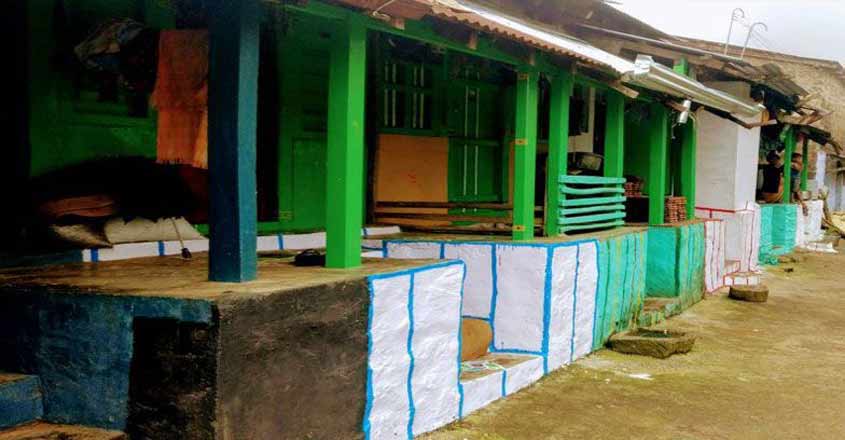Vellagavi: A village of barefoot residents in the middle of the forest

The 12-km trek from Top Station in Munnar to Kurangini would feel child's play compared to this trek to Vellagavi.
The 12-km trek from Top Station in Munnar to Kurangini would feel child's play compared to this trek to Vellagavi.
The 12-km trek from Top Station in Munnar to Kurangini would feel child's play compared to this trek to Vellagavi.
A village in the hills where nobody wears footwear! That is the attraction of Vellagavi near Kodaikanal drawing travellers who undertake an arduous trek through dense forest.
The 12-km trek from Top Station in Munnar to Kurangini would feel child's play compared to this trek to Vellagavi. The route is along the Kumali - Dindigul road and travellers can turn towards Kumbakkara at Periyakulam.
It is from Kumbakkara that the trek starts. The distance is just 8 km, but it may take up to 6 six hours to cover. Travellers from Kodaikanal side can start the journey on foot from Vattakanal. It is a distance of 6 km, taking 4 hours.
A van takes visitors through Tamil Nadu villages to a plantation growing dwarf mango trees. From here, one has to walk to the valleys of the Kodai mountains. Steep hills and thick woods lie in front of travellers. The path is very narrow, allowing only one person to pass at a time. The climb is steep and lemons grow in abundance on both sides.
A deep depression flanks both sides of the narrow path and any misstep can lead to a fall. The sounds of the forest creatures greet travellers. The pure air is a bonus.

Indescribable beauty of the landscape provides a feast for the cameras. Villagers lead donkeys carrying loads or goat herds along the path. Tiny shrines line the sides of the path. They present a curious sight with a spear, bells and tiny images on a platform.
When the day advances, the steep climbs prove exhausting for several visitors. But clear and clean water can be tasted from the forest streams on the way, to quench the thirst.
Local people quickly overtake you even while carrying heavy loads along the path covered with big pebbles. Any person you enquire with would reply, “The village is nearby.”
But the hours pass by without notice. While one hill is covered, the next one looms. Gooseberry trees line the path and you can pick some and chew to get some relief.
Soon, a wonderful sight awaits travellers. While orange farms spread on one side of the path, coffee and cardamom grow in abundance on the other. A tiny water-fall can also be seen in the middle of the farmland.
The route ahead is an incline covered with sharp and big stones which is flanked by massive trees. A little along this path, beyond a curve, is Vellagavi.
The first sight that greets visitors at Vellagavi is a temple, beyond which nobody uses footwear. There are 25 temples in this tiny village of around 150 people. The local people consider the entire village as a holy place where footwear is not allowed. Belief is supreme among the villagers here.
All the houses are built along straight rows side by side and are covered with sheets or are thatched. 'Kolam' art is seen in front of all dwellings, which are painted with multiple colours. Art also appears on the walls of the house. Some paths between houses are laid with cement.
Temples rise between houses and also at the end of the streets. In front of each temple, at least two or three persons can be seen praying all the time. The annual temple festival is the biggest event of the village.
Every face in the village greets visitors with a smile. On Sundays, the entire area resonates with the voices of kids, who are shy in front of the camera.
The only school in Vellagavi has classes only up to the lower primary level. Teachers reach here from Periyakulam and Kodaikanal. For higher studies, the children have to depend on the towns.
No medical facilities or other essential services are available at Vellagavi and local people have to carry sick people to hospitals. The only establishments in the village are a tea shop and a small provision store. The tea shop now provides a camp set-up too, considering the regular visitors arriving at Vellagavi.
Farming and rearing of goats are main occupations of the villagers, who get piped water from Vattakanal. Having a history of 300 years, Vellagavi is older than Kodaikanal, but the government seems to have no interest in developing the village. The local people suffer everything in silence.
During the return, travellers can choose to trek to Vattakanal. Beyond the temple are the stone steps which lead to the path covered with red soil. This path is better than the one from Kumbakkara as it is well-trodden with regular use. Villagers from Vellagavi often head to Kodaikanal town along this path for buying essential items. Here too, dense forest flanks both sides and ascends, descends, twists and turns are aplenty. Barefoot villagers pass visitors, but all of them enquire about your well-being.
Innocence of the rural dwelling in the forest is clearly evident. Soon eucalyptus trees come into view, indicating that Dolphin Nose viewpoint in Kodaikanal is nearby. From the top of the rock, Vellagavi's lights at night can be seen in the distance. From Vattakanal, a vehicle can take you to Kodaikanal town.
